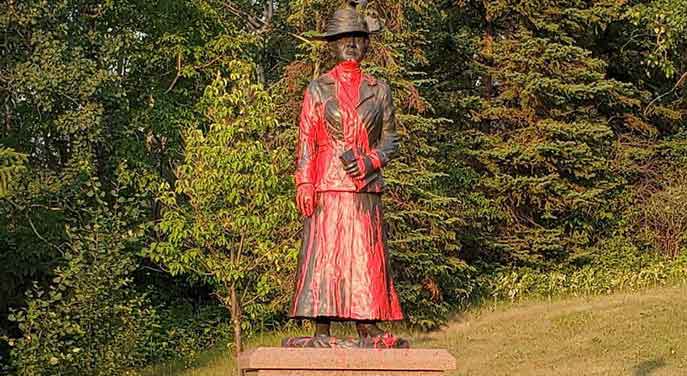 Oh, dear, the statue-defacing vigilantes are at it again!
Oh, dear, the statue-defacing vigilantes are at it again!
One of the latest targets is erstwhile Canadian feminist icon Emily Murphy (no relation). Her Edmonton statue got the red paint treatment in mid-July.
Predictably, the ‘racist’ epithet was deployed. Indeed, the National Post’s news story went beyond merely noting the racist allegation. It accepted it as a statement of fact.
Before we get to the nub of the issue, let’s take a look at who Murphy was.
She was born in Cookstown, Ont., in 1868, the third child of Isaac and Emily Ferguson. The Fergusons were recent Irish Protestant immigrants, relatively well off and politically connected. When Emily was 19, she married an Anglican clergyman named Arthur Murphy. He, too, was the child of Irish immigrants.
Murphy’s first brush with fame was pseudonymous. Using a pen name, she wrote The Impressions of Janey Canuck Abroad, a book inspired by her experience accompanying her husband on an 1898-99 preaching tour of England and Germany. It was a hit in 1901 and launched her career as a published author and magazine contributor.
Murphy’s feminist activism dates from the family’s move to Alberta. There, she became engaged with the subject of married women’s property rights, resulting in the provincial legislature passing the Dower Act of 1911. And in 1916, she had the distinction of becoming the first female magistrate in the British Empire.
Most prominently, she was the lead protagonist in what became known as the Persons Case, sometimes described as “among the most significant in Canadian constitutional history.” Decided in 1929, the case went all the way to the Judicial Committee of the Privy Council (JCPC) in London, at that time the ultimate arbiter of Canadian law.
The JCPC decision overruled that of the Supreme Court and established that women were indeed “persons” under Canadian law and thus eligible to hold any political office, including Senate seats. More broadly, the decision is often credited with being instrumental in promoting the concept of the Constitution as a “living tree” and thus not constrained by the literal meaning of the words.
Now for the racism bit.
During her years as a magistrate, Murphy was exposed to the illicit drug trade’s deleterious consequences. And combatting it became a personal cause, on which she did substantial research and writing. In 1922, a collection of her related work was published in book form as The Black Candle.
Read today, The Black Candle is striking for the bluntness of its language. There’s no attempt at euphemisms or beating around the bush. Nor is there any shying away from expressing conclusions or judgments on behaviour.
One of those conclusions pertains to what Murphy saw as the prominent drug trafficking role of non-white immigrants, particularly those of Chinese background. In the process, she refers to the Chinese as “visitors” in Canada, noting that, if the “visitor” engages in drug trafficking, “it might seem wise to put him out.”
But she also excoriates the drug trade role of “many Anglo-Saxons, men prominent in social and business circles.” And she adds: “Let us punish these foreign immigrants if they deserve it; let us exclude them from our country if our policy so impels, but let us refrain from making them the eternal scapegoats for the sins of ourselves or of our children.”
This, then, is Murphy’s offence. She was a ‘racist’ because she had an ethno-centric, ancestry-based view of what constitutes a nation. Other people were foreigners or visitors.
In the Post’s telling, she wanted Canada (presumably outside Quebec) to develop as a white, Anglo-Saxon country. (Actually, given the large Irish and Scottish presence and her background, whatever preference Murphy had would’ve been Anglo-Celtic rather than Anglo-Saxon.)
However, the idea of countries as homelands for ancestrally identifiable groups – whether defined by ethnicity or tribe – was extraordinarily prevalent in Murphy’s time. It still persists over much of the world. And it’s not a peculiarly white or European perspective.
If that qualifies Murphy as a ‘racist,’ then pretty much anyone who lived anywhere 100 years ago was one. And probably most of the world’s population today, irrespective of colour, fits into that category.
One wonders about the practical utility of such a discourse. Rather than shedding light, it merely serves as an ideological cudgel.
Troy Media columnist Pat Murphy casts a history buff’s eye at the goings-on in our world. Never cynical – well, perhaps a little bit. For interview requests, click here.
The views, opinions and positions expressed by columnists and contributors are the authors’ alone. They do not inherently or expressly reflect the views, opinions and/or positions of our publication.
© Troy Media
Troy Media is an editorial content provider to media outlets and its own hosted community news outlets across Canada.



